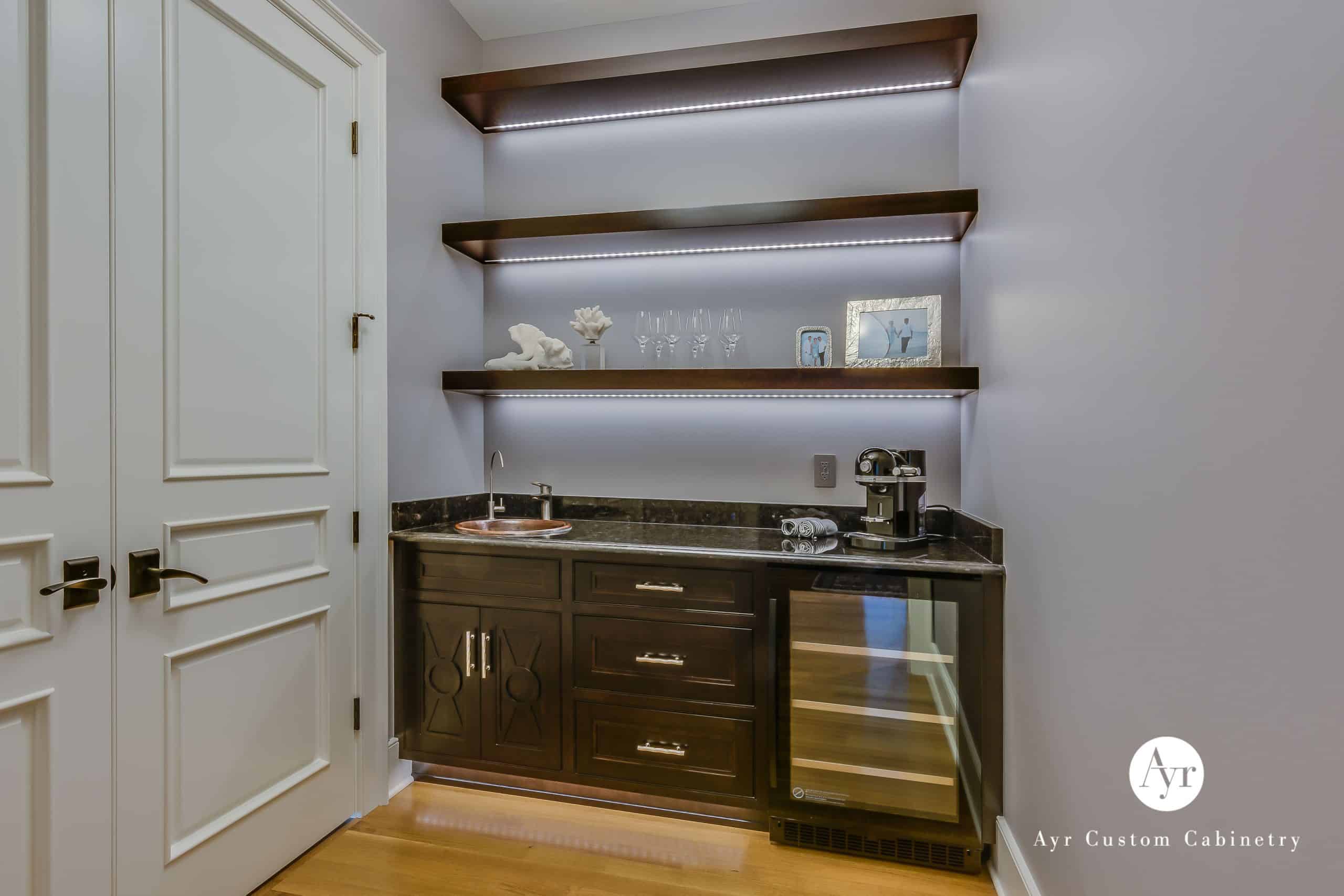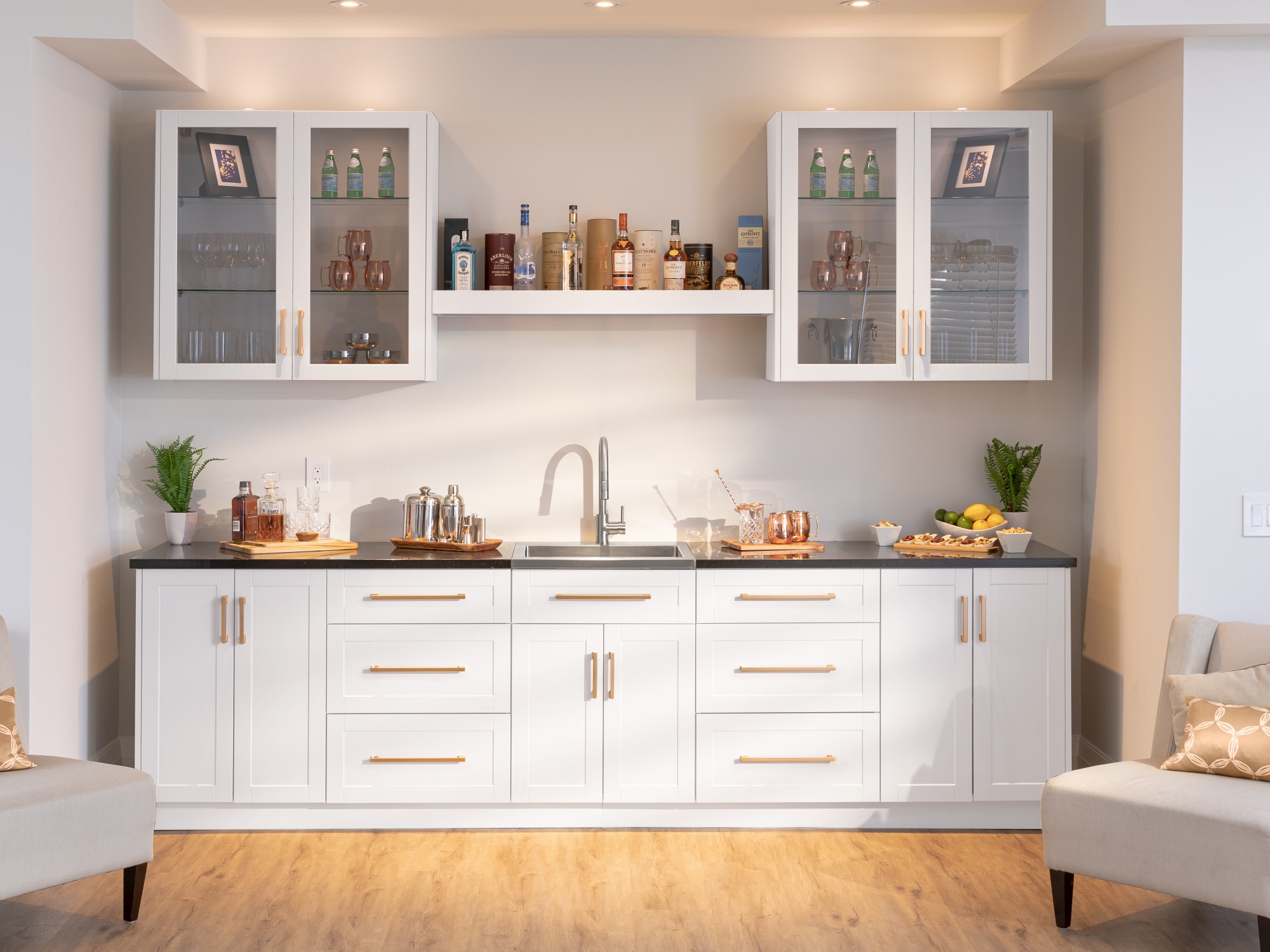Standard Wet Bar Cabinet Dimensions

Designing a wet bar involves careful consideration of space and functionality. Standard dimensions offer a starting point, but customization is key to achieving the perfect fit and aesthetic for any home. Understanding these dimensions is crucial for both homeowners and contractors involved in the planning and installation process.
Standard Wet Bar Cabinet Dimensions by Configuration
The dimensions of wet bar cabinets vary significantly depending on their configuration and intended use. The following table provides a general overview of standard dimensions for common configurations. Note that these are averages and can vary by manufacturer.
| Configuration | Width (inches) | Depth (inches) | Height (inches) |
|---|---|---|---|
| Freestanding | 36-72 | 24-28 | 34-36 |
| Corner | 30-48 (per side) | 24-28 | 34-36 |
| Under-Counter | 24-48 | 22-24 | 34-36 |
Typical Interior Dimensions and Features
Internal dimensions are crucial for accommodating appliances and storage. Adequate space is necessary for convenient use.
Wet bar cabinet dimensions – The following points Artikel typical interior dimensions and features of wet bar cabinets:
- Sink Space: A standard undermount sink typically requires a minimum of 18 inches in width and 15 inches in depth. Larger double sinks will naturally require more space.
- Refrigerator Space: A built-in refrigerator needs sufficient space to allow for proper ventilation. Dimensions vary depending on the refrigerator model, with a common range of 24-36 inches in width and 24 inches in depth.
- Shelving Space: Shelving should be deep enough to accommodate bottles and glassware, typically around 12-15 inches. Adjustable shelving is recommended for versatility.
- Storage Space: Additional space for storage of bar tools, mixers, and other accessories should be considered, with adjustable shelving or drawers offering maximum flexibility.
Wet Bar Cabinet Layouts for Different Spaces
The design of a wet bar should complement the available space. Below are examples of layouts suitable for small, medium, and large spaces.
Small Space Layout (48 inches wide): This design prioritizes efficiency. It features a compact under-counter sink (24 inches wide), a narrow shelf above the sink for glasses, and a small section for storing bottles. The total depth remains within the 24-inch standard.
Medium Space Layout (72 inches wide): This layout incorporates a larger under-counter sink (36 inches wide), a dedicated area for a small built-in refrigerator (24 inches wide), and ample shelving for storage. This configuration offers improved functionality and storage capacity.
Large Space Layout (96 inches wide): This design provides generous space. It includes a double undermount sink (48 inches wide), a full-size built-in refrigerator (36 inches wide), extensive shelving, and potentially a dedicated area for an ice maker. This layout maximizes functionality and offers a more luxurious experience.
Custom Wet Bar Cabinet Design Considerations

Designing a custom wet bar involves careful consideration of several key factors that directly impact both the functionality and aesthetics of the finished product. The dimensions of the cabinet are not merely a matter of personal preference; they are inextricably linked to practical constraints and desired features. Optimal design requires a holistic approach, balancing desired storage, appliance integration, and plumbing requirements within the available space.
Plumbing Requirements and Appliance Integration Significantly Influence Wet Bar Cabinet Dimensions
Plumbing requirements, in particular, dictate minimum cabinet depths and internal configurations. The space needed for sink plumbing, drain lines, and water supply lines must be factored into the overall design. Appliance dimensions, including the size of the refrigerator, ice maker, and dishwasher (if included), further constrain the available space and influence the cabinet’s overall footprint. For instance, a larger under-counter refrigerator will require a wider cabinet than a smaller, more compact model. Similarly, the inclusion of a dishwasher necessitates a cabinet deep enough to accommodate both the appliance and sufficient counter space for loading and unloading.
Prefabricated Versus Custom-Built Wet Bar Cabinets: Size and Cost Analysis
Prefabricated wet bar cabinets offer a cost-effective solution for standard-sized spaces, but their limitations in terms of customization can be significant. While generally less expensive upfront, they often lack the flexibility to accommodate unusual spaces or specific design requirements. Custom-built cabinets, conversely, offer unparalleled flexibility in size and design, allowing for precise tailoring to the available space and the homeowner’s specific needs. However, this flexibility comes at a premium, with custom-built cabinets typically costing significantly more than prefabricated alternatives. The price difference can be substantial, potentially ranging from hundreds to thousands of dollars, depending on the complexity of the design, materials used, and the level of craftsmanship involved. The choice between prefabricated and custom-built cabinets depends heavily on budget and the degree of design flexibility required.
Maximizing Space and Functionality in Wet Bar Cabinets with Unusual Dimensions or Layouts, Wet bar cabinet dimensions
Unusual spaces often present unique challenges in wet bar design. However, creative solutions can maximize both space and functionality.
For example, a narrow, deep space might be better suited to a vertical design, utilizing tall, narrow cabinets for storage and incorporating a pull-out shelf system for increased accessibility to items stored at the back. This vertical orientation allows for a significant amount of storage in a space that might otherwise be unusable for a traditional wet bar. Careful planning of shelving and drawer placement is crucial to avoid wasted space.
Conversely, a short, wide space can benefit from a horizontal design, featuring a long countertop with integrated shelving above and below. In this configuration, multiple appliances can be placed side-by-side, maximizing counter space for food preparation and serving. The addition of corner shelving or custom-designed corner cabinets can further enhance storage capacity in this type of layout.
In spaces with limited depth, using slimline appliances and maximizing vertical space is key. This might involve opting for a shallower sink, a slimline refrigerator, and utilizing the space above the countertop for storage. Clever use of mirrors on the back wall can also create an illusion of more space, enhancing the overall feel of the wet bar.
Wet Bar Cabinet Installation and Space Planning: Wet Bar Cabinet Dimensions

Installing a wet bar cabinet requires careful planning to ensure both functionality and aesthetic appeal. Proper space planning and attention to detail during installation are crucial for a successful project, minimizing potential problems and maximizing the bar’s utility. Ignoring these aspects can lead to costly rework or a less-than-ideal finished product.
Step-by-Step Installation Guide
A methodical approach to installation is key. The following steps provide a framework for a successful project.
- Site Preparation and Measurements: Before purchasing or building the cabinet, meticulously measure the designated space. Account for wall irregularities, existing plumbing and electrical lines, and any obstructions. Create a detailed scale drawing indicating all dimensions, including height, width, and depth. Note the locations of electrical outlets, water supply lines, and drain lines.
- Electrical Considerations: Determine the required electrical outlets for appliances like a refrigerator, ice maker, or blender. Consult with a qualified electrician to ensure proper wiring and grounding for safety and compliance with local building codes. The electrician should install outlets at appropriate heights and locations, considering the placement of appliances and countertop space.
- Plumbing Requirements: Plan for the installation of water supply lines for the sink and ice maker (if applicable). This involves running supply lines from the main water source, ensuring sufficient pressure and proper connections. Also, plan for the drain line, ensuring proper slope and connection to the main drain system. A licensed plumber should handle this stage to ensure compliance with plumbing codes and prevent leaks.
- Ventilation Planning: If incorporating appliances that generate heat or moisture, such as a refrigerator or dishwasher, adequate ventilation is critical. This might involve installing a ventilation fan or ensuring sufficient airflow to prevent moisture buildup and potential damage to the cabinet and its contents. Consider the location of vents and their connection to an external exhaust system.
- Cabinet Installation: Once the electrical and plumbing work is complete, carefully install the wet bar cabinet, ensuring level placement and secure fastening to the wall studs. Follow the manufacturer’s instructions for assembly and installation. Precise measurements are crucial to avoid gaps or misalignments.
- Finishing Touches: After installing the cabinet, connect the plumbing and electrical components, ensuring proper sealing and connections. Install the countertop, sink, and other fixtures. A final inspection should be performed to check for leaks, electrical faults, and any other issues before using the wet bar.
Accurate Space Measurement Techniques
Accurate measurements are fundamental to a successful wet bar installation. Inaccurate measurements lead to ill-fitting cabinets, compromising both functionality and aesthetics.
Precise measurements should be taken at multiple points to account for irregularities in walls or floors. Use a measuring tape and level to determine the exact dimensions of the space. Consider the depth required for appliances and adequate workspace around the bar. A detailed sketch, including all measurements and the location of plumbing and electrical fixtures, is essential before purchasing or building the cabinet. For example, a standard depth for a wet bar might be 24 inches, but you may need to adjust this based on the appliances and desired countertop space. Always measure twice and cut once, especially when dealing with plumbing and electrical installations. Consider creating a three-dimensional model of the space using drafting software or sketching to visualize the final product and anticipate potential challenges before installation.
Essential Tools and Materials Checklist
Having the necessary tools and materials readily available streamlines the installation process. A comprehensive checklist ensures a smooth and efficient installation.
- Measuring tape
- Level
- Stud finder
- Drill with various drill bits
- Screwdrivers (Phillips and flathead)
- Wrench set
- Pliers
- Safety glasses
- Work gloves
- Cabinet mounting hardware
- Plumbing supplies (pipes, fittings, sealant)
- Electrical supplies (wires, outlets, junction boxes)
- Silicone caulk
- Countertop material
- Sink and faucet
